Cooper Tires’ #RideNDrive Event
This is a Sponsored post written by me on behalf of Cooper Tires for SocialSpark. All opinions are 100% mine.
You may have noticed last week that I didn’t post any articles written by me and there weren’t quite as many posts all around as you may have come to expect if you follow this site regularly, which you should as learning new things every day is good for the long term health of your brain. Plus, you’ll never be want of something to say at cocktail parties. There’s really no downside here.
The reason why I wasn’t around was that I decided to go against my normal rule and step away from my computer, venturing out into something called “outdoors”, attending the Cooper Tires #RideNDrive event in San Antonio, Texas. Lucky for me, the peculiar glowing orb in the sky I encountered while out of doors was covered by a water vapor layer for about half the event, therebye helping to minimize my exposure to so-called “natural” light. (I’ll stick with light bulbs and the glow of my computer screen thank you very much.)
In any event, Cooper Tires offered to fly me down and let me extensively test out some of their tires compared to equivalent (in terms of target utility and price range) BFGoodrich tires. Specifically, they let me race around Mustang GTs and Corvettes on their 1,000 acre vehicle test center, racing the cars on wet and dry tracks at purposefully extreme speeds in order to put the tires through their paces (ultra high performance, all-season Zeon RS3-A and the ultra high performance, summer RS3-S). They also let me test out some tires on Chevy Tahoe SUVs on the wet track and on Jeeps in a variety of extreme off-road conditions. In both cases, the vehicles were equipped with the Discoverer A/T3 all terrain / all-season tires, which incidentally was recently rated by Consumer Reports as the “number one ranked all-terrain SUV and pickup tire”.
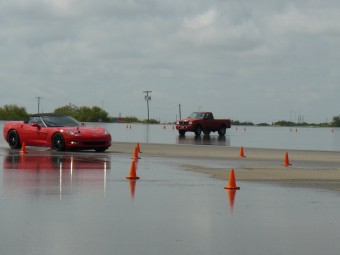
Racing the Corvette on the wet track with the cone fixer in the truck.
Needless to say, they had me at “racing a Corvette on a track”. There was also some riding around on the tracks with a couple professional drivers, including IndyCar driver and three time winner of the ALCAN 5000 rally, Johnny Unser, which resulted in one individual getting quite nauseous (not me, thankfully) from flying around the track at pretty amazing speeds. The one person ultimately had to sit out for about half one of the day’s events because of his trip around the track with Unser. 
Being someone who always buys the cheapest tires possible as a rule, I’d never fully appreciated the difference between the bargain basement tires and good high performance tires. Both the BFGoodrich tires and the Cooper Tires performed amazingly well compared to my normal bargain basement types. What was surprising, to me at least, was how much better the Cooper Tires performed over the BFGoodrich tires. Going into it, I assumed they’d be pretty similar in performance, both being high end models of tires and name brands. Granted, I figured the Cooper Tires would outperform the BFGoodrich tires by some noticeable margin, else the Cooper Tire people likely would have picked a different manufacturer’s equivalent utility and price range tire for us to compare theirs too. But the difference was a lot more than just marginal when driving the tires on both the wet and dry tracks.
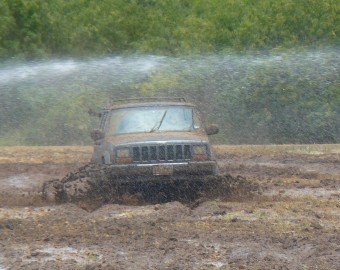
Testing the Discoverer A/T3's in the Mud
Specifically, on the wet tracks with the Mustangs, Corvettes, and Chevy Tahoes, the BFGoodrich tires really struggled to grip around corners at relatively high speeds, particularly in the Chevy Tahoes which almost felt like driving on ice at times, even though it was just wet pavement. This was particularly troublesome when it came to trying to turn and the front wheels choosing instead just to slip out. Obviously there are ways to compensate for this, besides just going slower, but it’s much better when the car actually turns when you tell it to without resorting to more advanced driving skills. On the track this is important because there are a lot of people watching and you don’t want to get branded with the nickname “Cone Crusher” as one of my compatriots was (Mike Bonfonti, who now will forever be linked to that nickname thanks to the miracle of web search). 
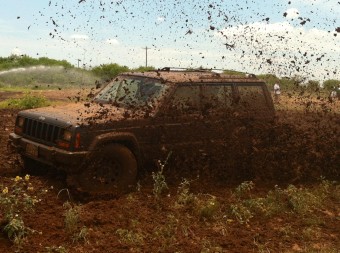 The RS3-A and RS3-S Cooper Tires performed amazingly well in this respect. I could go significantly faster without the front end slipping out and even when going fast enough to get the back end to slip out, thanks to the fact that the front of the car was still easy to control, compensating for the rear slip was extremely easy. In the most extreme cases, when I’d go fast enough to have the front slip out even with the Coopers, regaining control was also much quicker with the RS3-A and RS3-S tires.
The RS3-A and RS3-S Cooper Tires performed amazingly well in this respect. I could go significantly faster without the front end slipping out and even when going fast enough to get the back end to slip out, thanks to the fact that the front of the car was still easy to control, compensating for the rear slip was extremely easy. In the most extreme cases, when I’d go fast enough to have the front slip out even with the Coopers, regaining control was also much quicker with the RS3-A and RS3-S tires.
So in maneuverability at high speeds both on a wet road (I believe they had it set at about .15 inches of water when I was on it) and on a dry track, the Cooper Tires significantly outperformed the BFGoodrich tires, something again, which surprised me in terms of how much of a gap there was between the two in performance.
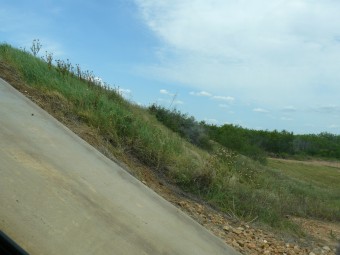
Going up a steep polished concrete covered in water incline... nary a slip, even when stopping and starting
Going beyond maneuverability, with stopping distance, the Coopers performed a little better than the BFGoodrich tires, though the gap between the two was more reasonable here at least.
If you follow my sponsored posts, you probably notice I usually say something good about the product I’m covering. This isn’t because I’m willing to say whatever positive thing whoever wants me to, but because I don’t take sponsored posts when I know I’m going to give a bad review after looking over what they want me to review. In this case, though, I was at least willing to cover the product due to the awesome #RideNDrive trip included; so for once I wasn’t actually sure I’d be saying something positive when I covered the tires. Particularly as I’ve always been one who found bargain basement tires generally adequate.

The view from the Jeep while climbing the extremely steep incline
This seemed fine though, as they never asked me to say anything positive at any point. They simply asked that I mention “what tires were tested” and “what conditions [I] tested them in.” That was pretty much it. Everything else was open. But, as you can tell from the above review, I was genuinely impressed both with the tires and the many Cooper Tire employees themselves, including some of the designers, I met throughout the three day event (they were there all the time through the whole thing, even late into the evenings, to answer any questions).
If you’re interested, you can feel free to follow Cooper Tire on Twitter here and can view tweets by myself and others at the #RideNDrive event here.
Bonus Facts:
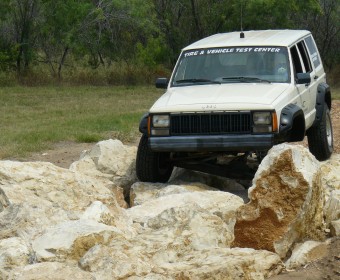 The natural color of rubber is white, not black, as many people think. Why rubber is made black isn’t just for cosmetic reasons, but because adding chemicals like carbon black to the rubber drastically increases desirable qualities of the rubber. Specifically, adding about 50% by weight of carbon black increases the road-wear abrasion of the produced tire by as much as 100 fold and improves the tensile strength of the tire by as much as 1008%. Adding carbon black also helps conduct heat away from certain hot spots on the tire; specifically, in the tread and belt areas, which can get particularly hot at times while driving. This reduces thermal damage to the tire, which further extends its lifespan.
The natural color of rubber is white, not black, as many people think. Why rubber is made black isn’t just for cosmetic reasons, but because adding chemicals like carbon black to the rubber drastically increases desirable qualities of the rubber. Specifically, adding about 50% by weight of carbon black increases the road-wear abrasion of the produced tire by as much as 100 fold and improves the tensile strength of the tire by as much as 1008%. Adding carbon black also helps conduct heat away from certain hot spots on the tire; specifically, in the tread and belt areas, which can get particularly hot at times while driving. This reduces thermal damage to the tire, which further extends its lifespan.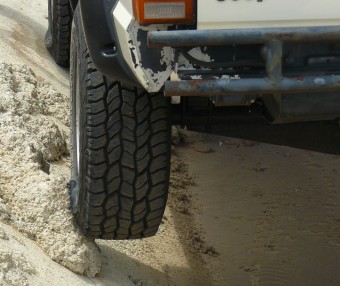 The use of carbon black in rubber was originally proposed by Binney & Smith, the same company that invented Crayola Crayons. They began selling their carbon black to the Goodrich Tire Company, which is when white tires started disappearing on cars in favor of the much superior black tires. Carbon black itself is simply nearly pure elemental carbon in colloidal particle form. It is classically made by charring any organic material.
The use of carbon black in rubber was originally proposed by Binney & Smith, the same company that invented Crayola Crayons. They began selling their carbon black to the Goodrich Tire Company, which is when white tires started disappearing on cars in favor of the much superior black tires. Carbon black itself is simply nearly pure elemental carbon in colloidal particle form. It is classically made by charring any organic material.- Rather than using carbon black in shoes, the more common additive to the rubber is fumed silica, which has similar reinforcing properties as carbon black, but leaves the rubber white. The downside of using silica-based additives on automotive tires is that they have much worse abrasion wear properties than tires with carbon black. However, they do offer better handling on wet surfaces and have a lower rolling loss, which increases fuel efficiency. Because of this, there are some tires that are starting to be made with silica-based additives, instead of carbon black.
- Around 70% of all carbon black pigment used in the word today is used for tires. Another 20% goes into belts, hoses, and other such rubber items. Most of the remaining 10% go into black coatings for items, as well as inks and toner in printing.
Carbon black is not the same thing as activated carbon or soot. Carbon black has a much higher surface area to volume ratio than soot and also has much less polycyclic aromatic hydrocarbon in it. -
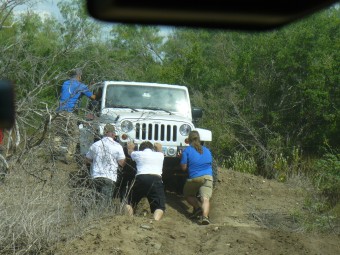
All the traction in the world doesn't help if the tires aren't touching the ground... and no, I wasn't driving that one, I'm turned around taking the picture after successfully making it over that large hump.
No one knows exactly where the word “tire” derives from. The leading theories are that it either derives from “attire” or from “to tie”. The earliest tires were simply bands of iron or other metal. The application of the metal band on the wooden wheels was accomplished by heating the metal tire, then placing it over the wooden wheel. Next, they would douse it in cold water, which would cause the metal to rapidly contract and secure itself to the wheel, with the outer ring “tying” the wheel together, hence the proposed “tie” origin.
- The first practical pneumatic tire was developed by John Boyd Dunlop, who was originally a veterinarian. He created the tire to help his son who suffered from headaches when riding his bike. The rubber tire made for a much smoother ride for him on rough roads than wooden wheels.
- Silly Putty, made from boric acid mixed with silicone oil, was originally invented by accident when a General Electric employee was trying to create synthetic rubber, due to the fact that Japan had invaded various rubber producing countries in the Pacific Rim creating a shortage of rubber which was hurting certain U.S. wartime production efforts.
- Cooper Tires is the ninth largest tire manufacturer in the world and the fourth largest in the United States. They currently gross around $4 billion per year and employee about 13,000 people.
-
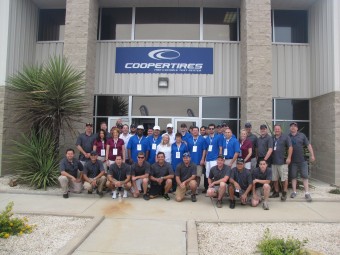
Group Picture
Cooper Tires was started by two brothers-in-law John F. Schaefer and Claude E. Hart in 1914. In the beginning, they purchased a company that produced tire patches and tire repair kits. From there they expanded into the tire rebuilding businesses and eventually into making tires themselves when they merged in 1930 with The Cooper Corporation.
- Due to various products they manufactured for the United States during WWII, including boats, waterproof bags, life jackets, etc., the U.S. awarded Coopers with an Army-Navy ‘E’ Award in 1945.
- According to Consumers Digest, the Zeon RS3-A “delivers the best braking, and hydroplaning resistance of any performance tire under $200”.
- Consumer Reports rated the Discovered A/T3 as the number one ranked all-terrain SUV and pickup tire out of all the similar tires they tested, rating it “excellent for snow traction, very good for dry braking, wet braking, hydroplaning resistance, ride comfort, and tread life… Good for warm-weather, handling, and quite ride… Fair for ice breaking performance and low rolling resistance…” and zero “poor” marks.
| Share the Knowledge! |
|

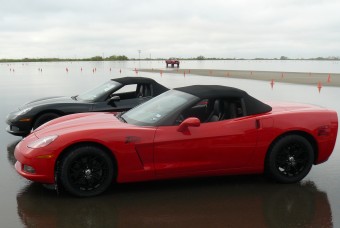




great post, thanks
– our FixOrRepairDaily trucks are all happily Cooper shod
– yikes…v.little natural sunlite exposure is the path to baldness,constipation,eye diseases++Death
– the Thyroid requires sunshine vit D to function to keep us alive [the pill forms are rat poison]
hmmm, now that could be a future TIFO topic,eh?
cheers